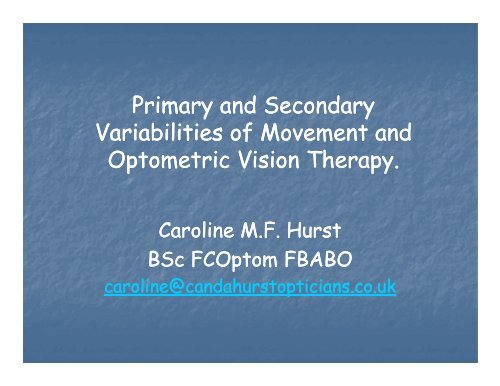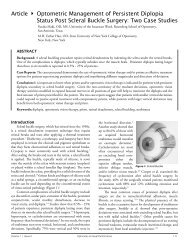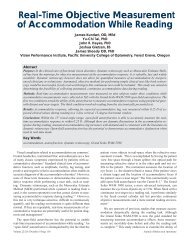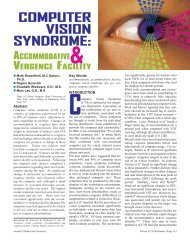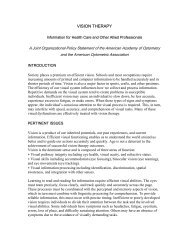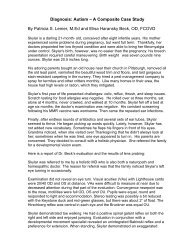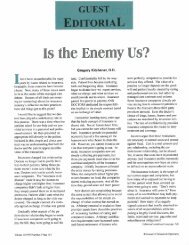Caroline Hurst.pdf
Caroline Hurst.pdf
Caroline Hurst.pdf
You also want an ePaper? Increase the reach of your titles
YUMPU automatically turns print PDFs into web optimized ePapers that Google loves.
Primary and SecondaryVariabilities of Movement andOptometric Vision Therapy.<strong>Caroline</strong> M.F. <strong>Hurst</strong>BSc FCOptom FBABOcaroline@candahurstopticians.co.ukcandahurstopticians.co.uk
Themes• Cyclical learning ofmovement and sensorypathways.• Primary and secondaryvariabilities ofmovement.• OVT and the wholeperson.
VisioniVision• Taking meaning ng from allsensory input,• relating it to previousexperience.• Vision is then used todirect action.
VisioniVision• Seeing with meaning,understanding di andpurpose.• The dominant process inhuman behaviour.• Results in a mentaland/or physical action.
Posture and Postural ControlPostural control; a keyissue in developmentaldisordersby Hadders Algra andCarlberg.
Posture:Posture and Postural Control• The relationship between theparts of the body, and• between the body and anexternal reference frame.• Static, and dynamic balanceas we make movements, withreference to gravity.
Posture and Postural ControlPostural control is an active processas the person explores the limits ofstability.• Reactionary: in response to anexternal change.• Anticipatory: preparing p for a goaldirected action.Brandon n Jacobs, 6ft 4in, 265lb4.52s 40-yard dash
Posture and Postural Control• Postural control takessensory input from the visualsystem, vestibular apparatusand proprioception.• Postural control andmovement are part of thevisual process, and areneeded to pass fromperception to action.
Posture and Postural ControlThe visual process dependson postural stability todirect action successfully.
How is the visual process learned?Development of posturalcontrol and movementintrinsically linked.• Most movements requirepostural adjustments.t• Both require a long processof neurodevelopment.• Adult postural adjustmentsare not seen until lateadolescence.
How is the visual process learned?Development and learning ng in the first year of lifeestablish the relationship between a movement andthe perception of the sensory input from thatmovement.
How is the visual process learned?Motor and sensory pathways are learned at the sametime.ModifiedmovementSensory afferentMovement information
Early Experience, the Brain and Consciousness,Dalton and Bergenn‘…movement is anintrinsic andineradicable element ofeach and every sensoryperception’.
Early Experience, the Brain and Consciousness,Dalton and Bergenn‘Perceptual knowledge depends on the relationshipbetween:-• posture that t furnishes the ground,• the spatial position of the object in view,• intersensory judgement, and• proprioceptive feedback.All four variables and their interrelationship undergochange as a result of growth and changes in mobility’.
How is the visual process learned?Motor developmenttheories• Gesell and Amatruda• Kugler, Thelen• Hadders Algra
Neural Maturation(Gesell, Amatruda 1945)Nature response• Predetermined d patterns,• Within the constraints of genetics,• Increasing cortical control.• Late attainment, and/orabnormalities in muscle tone andreflexes.
Nurture responsesDynamic Systems Theory(Kugleret al (1980) in Hadders-Algra2000Aug p 567)The effects of thecomponent parts eg bodyweight, muscle strength,postural control+The effects of theenvironmental conditionsand task requirements=Spontaneous, specificorganisation of behaviour.
Dynamic Systems Theory(Thelenet al (1995) in Hadders-Algra2000Aug p 567)• A dynamic system and aself organising g process.• A series of states ofstability bl and instabilityblas patterns ofmovement mwereattempted.
Primary and Secondary Variabilities(Hadders-AlgraM. 2000 Aug and Oct)Primary VariabilitySelectionSecondary Variability
Neuronal Group Selection Theory (NGST)(Edelman and Tononi 2000)
Neuronal Group Selection Theory (NGST)• Cortical and subcortical systemsorganised into variable networks.(Edelman and Tononi 2000)• The structure and function of eachnetwork is selected by developmentand behaviour.• The units for selection are collectionsof hundreds to thousands of stronglyconnected neurones called neuronalgroups.• The brain selects which groups will bekept or discarded.
Neuronal Group Selection Theory (NGST)(Edelman and Tononi 2000)• The NGST bases selection onDarwinian principles of populationand natural selection.• Not only does natural selectionapply within species, but applies assomatic selection within a singlebody to give the variation andselection of individual cell systems.• So the selection of a group to bekept depends on the survival of thefittest.
Neuronal Group Selection Theory (NGST)(Edelman and Tononi 2000)Natural selection fromgenetics+Somatic selection fromexperience+Re-entrant entrant pathways
Neuronal Group Selection Theory (NGST)Developmental Selection(Edelman and TononiTononi 2000)• Initial anatomy determined bygenes and inheritance,• Neurones extend withextensive variability, diverseprimary repertoire ofconnections.
Neuronal Group Selection Theory (NGST)Developmental Selection(Edelman and TononiTononi 2000)• Neurones strengthen andweaken their connectionsaccording to individual patternsof electrical activity.• Neurones that fire togetherwire together, forming closelyconnected groups.• Slight reduction in variabilityafter selections have beenmade.
Neuronal Group Selection Theory (NGST)Experiential Selection(Edelman and TononiTononi 2000)• Secondary repertoiresdevelop thru experientialselection.• Overlaps developmentalselection and continuesthroughout life.• Synapse connection selectionswithin the repertoires ofneurological groups that aredetermined by behaviouralexperience.
Neuronal Group Selection Theory (NGST)Experiential Selection(Edelman and TononiTononi 2000)• Selection on the basis of theafferent sensory informationproduced by a behaviour,movement or experience.• Experiential selection allows forsituation-specific specific neuronalgroups, and allows fordevelopment of volitionalvariable behaviour which can beadapted to environmentalsituations.
Neuronal Group Selection Theory (NGST)Re-entrant entrant mapping(Edelman and TononiTononi 2000)• Re-entryentry• Neuronal groups across thecortex and thalamus arearranged as maps.• There are reciprocal re-entrant entrantpathways that link across thebrain from one area to another.
Neuronal Group Selection Theory (NGST)Re-entrant entrant mapping(Edelman and TononiTononi 2000)• There are reciprocal pathwaysthat link maps that are alike,maps with associated functionand also maps that are in thelocal area.• Allows different parts of thebrain to respond to the samestimulus. As the re-entrant entrant pathways form a densemeshwork any disturbance in one area of the meshwork canbe felt rapidly elsewhere.
Neuronal Group Selection Theory (NGST)Re-entrant entrant mapping(Edelman and TononiTononi 2000)• Re-entry entry allows integration ofinformation from neuronalgroups across the thalamus andcortex, without the need for acentral coordinating area.• The synchronisation of theactivity of neuronal groups indifferent brain maps.
Neuronal Group Selection Theory (NGST)Re-entrant entrant mapping(Edelman and TononiTononi 2000)• Therefore, re-entry entry is thecentral mechanism by which thespace and time co-ordination ordination ofmotor and sensory events takeplace.• Re-entry entry ≠ Feedback.
Neuronal Group Selection Theory (NGST)Re-entrant entrant mapping(Edelman and TononiTononi 2000)• So, Developmental andExperiential selections providethe bases for great variabilityand differentiation of groups.• Re-entry entry allows the integrationof information between andwithin the primary andsecondary repertoires.
Neuronal Group Selection Theory (NGST)Re-entrant entrant mapping(Edelman and TononiTononi 2000)Two other major re-entry entryfunctions• Synchronisation of the spaceand time co-ordination ordination ofmovements.• Distinguishing g between figureand ground based oninteractions between brainareas for visual movement andshape.
Primary and Secondary Variabilities(Hadders-AlgraM. 2000 Aug and Oct)Primary VariabilitySelectionSecondary Variability
Primary and Secondary VariabilitiesPrimary Variability (HaddersHadders-AlgraM. 2000 Aug and Oct)• All forms of goal directed motor behaviours startwith primary variability.• The primary variability develops during foetal life andinfancy as a fundamental phenomenon, showingenormous variation.• Neural system explores all motor possibilities by selfgenerated activity + self-generated afferentinformation, within the constraints of genetics.
Primary and Secondary VariabilitiesSelection(HaddersHadders-AlgraM. 2000 Aug and Oct)• Experiential selection of most effective motorpatterns and their associated groups.• Transient minor reduction in variation of motorbehaviour.• Begins during infancy at function specific c ages, egreaching and grasping at 4 to 5 months.
Primary and Secondary VariabilitiesSecondary Variability (HaddersHadders-AlgraM. 2000 A and O)• Secondary variability shows a time of rapid increase insynapse formation and elimination.• Creation of secondary neural repertoires with a largecollection of parallel channels due to exposure to amultitude of experiences.• The long duration of the developmental processes insecondary variability means it may take years to reachefficient motor solutions for each specific movement.
Primary and Secondary VariabilitiesSecondary Variability (HaddersHadders-AlgraM. 2000 A and O)• Mature situation – task constraints: ability to adapteach movement exactly and efficiently to taskspecific conditions, or multiple motor solutions orstrategies for a single task.• Onset: function specific from mid-infancy infancy onwards.Starting to bloom at 2-3 years; mature in adolescence.
How does our understanding of primaryreflexes fit with these theories?• Part of the genetically determined primary repertoirethat is developed in the foetus.• For safety net, need to retain access to both primaryand secondary repertoires of motor response.• A choice of motor response depending on thesituation, and state of the individual e.g. fatigue,stamina, nutrition etc - 1º, 2º, or primitive reflex.
If a primary reflexive response to a stimulus istheir movement of choice it could be:-• they haven’t developed the secondary repertoireassociated with that stimulus,• they have a secondary repertoire but cannot accessit,• they haven’t developed the efficient sensorypathways to enable the development of secondaryvariability,
If a primary reflexive response to a stimulus istheir movement of choice it could be:-• both primary and secondary repertoires in place, butthey are unable to fine tune their motor output tospecific tasks,• they may have developed d both primary and secondaryrepertoires but lost them, or lost access to them dueto TBI, CVA etc,• the stress of the situation, and state of the person.Primitive reflex responses and gross motor skillsassessment - exploring and probing the primary andsecondary repertoires as well.
But where is the visual process in all this?• The motor development processes depend on thesensory afferent pathway to make selections.• But also, the sensory input links with previousexperience to give vision.• Therefore, the visual process is part of everyneuronal selection made to develop motormovements, and every movement made develops thesensory pathways.‘…movement is an intrinsic ns and ineradicable elementof each and every sensory perception’. Dalton
How do we learn the visual process?By developmental learning of movement, and sensoryafferent information processing skill,• initially from the primary variabilities, including thelearning from the primitive reflexes, and then• from more complex movements gaining g posturalcontrol and secondary variabilities of movement.This developmental learning builds to give a referencebase of previous experience.
Visual Process AssessmentThe Visual Process
Visual Process Assessment• Have they made the age appropriate postural controland movement development?• Have they made the movement pattern learning thatthey should have made from the primitive reflexes?• Can they locate themselves s in space and know how andwhere their body parts fit in space?• Can they direct themselves and their body partstoward a meaningful end?
Visual Process Assessment• Can they locate and identify significant others (thingsand people) as objects of action?• Have they the balance, poise, posture andunderstanding to move accurately, automatically andgracefully through space with their body, eyes andmind?• Can they take in the input, process and make theaccurate action, without expending excess energy?
Optometric t Vision i Therapy• We need to view the whole patient.• Look for weaker areas within the visual process.With OVT we could access thevisual process at any point onthis helix to make changes andinfluence both motor and sensorypathways.
Optometric Vision Therapy• OVT includes movements that open up access to theprimary and secondary repertoires of normalmovement development.• With neural plasticity the patient is gaining theopportunities to increase variability and makeselections, and gain the range of motor responsesthat they would normally have made.
• When you assess thepatient, whatever theirage, there is only thewhole person;Bottom up?• their performance withtheir visual process,• dependent on theirdevelopmental learning.
Principal References• Dalton TC, Bergenn VW, (2007) Early Experience, the Brain,and Consciousness Lawrence Erlbaum Associates, NY.• Edelman GM and Tononi G (2000) A Universe ofConsciousness, Basic Books, New York, USA.• Gesell A (1949) Vision: It’s Development in Infant and Child,OEPF, Santa Ana, CA, USA.• Hadders-AlgraM (2000 Aug) The neuronal group selectiontheory: a framework to explain variation in normal motordevelopment. Dev Med Child Neurol. 2000 Aug;42(8):566-72.• Hadders-AlgraM (2000 Oct) The neuronal group selectiontheory: promising principles for understanding and treatingdevelopmental motor disorders. Dev Med ChildNeurol.;42(10):707-15. 15.
Principal References• Hadders-AlgraM (2001) Early Brain Damage and theDevelopment of Motor Behaviour in Children: Clues forTherapeutic Invention? Neural Plasticity 8; 1-2, 31-49.• Hadders-AlgraM (2003) Developmental CoordinationDisorder: Is Clumsy Behaviour Caused By a Lesion of the Brainat an Early Age? Neural Plasticity 10, 1-2, 39-50.• Hadders-AlgraM, Brogren Carlberg E, (2008) PosturalControl: A Key Issue in Developmental l Disorders (Clinics inDevelopmental Medicine MacKeith Press• McClelland JL, Siegler R,(2001) Mechanisms of CognitiveDevelopment: Behavioral and Neural Perspectives (CarnegieMellon Symposium on Cognition), Psychology Press.• Piaget J (1936) The Origin of Intelligence in the Child, PenguinBooks Ltd, England.
Thank you, and enjoy the rest of ICBO!


